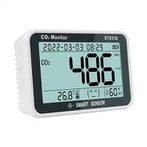Why not learn about the calibration and calibration of coating thickness gauges!
1. Zero calibration
The zero calibration is performed on the metal substrate (uncoated substrate) of this product.
1. Select a zero-adjustment board, which is an uncoated metal substrate (due to the different surface roughness of the workpiece, after zero-adjustment, re-measurement may not be an absolute zero position, which is a normal phenomenon);
2. On the side menu interface, select Calibration, then Zero Calibration, then press the probe vertically and firmly on the substrate, and the zero calibration will be performed automatically;
3. Repeat steps 1 and 2 above to obtain a more accurate zero point and improve measurement accuracy.
2. Multi-point calibration
Calibration is performed using standard sheets. This calibration method is suitable for high-precision measurement and small workpieces, hardened steel, and alloy steel.
1. Calibrate the zero point first;
2. Then take a measurement on a standard sheet whose thickness is approximately equal to the estimated thickness of the coating to be tested, and then correct the reading to make it reach the standard value;
3. Cover with multiple standard sheets, measure, and then correct the readings in turn to make it reach the standard value.
The standard thickness sheet is a thickness standard used to verify the indication error and variability of the EPK coating thickness gauge or to calibrate the coating thickness gauge. The calibration conditions of the coating thickness gauge are as follows: the temperature in the detection room is 20±2°C; the temperature balance time between the thickness sheet and the gauge block is 2 hours; the humidity in the detection room is ≤65%; the preheating time for the vertical optical meter is not less than 15 minutes; the power supply for the instrument is 220 (1±10%)V, 50Hz.
Specific requirements are as follows:
1. Appearance
There should be no defects such as scratches and bumps on both surfaces of the thickness sheet. The calibration method is visual observation.
2. Effective area
The area of a circle with a radius greater than 5mm should be marked for uneven surfaces, and the area of uniform surface thickness slices should not be less than 20mm×20mm. The calibration method is measured with a steel ruler.
3. Average of numbers
Use three equal gauge blocks and a vertical optical gauge to measure the thickness of the standard thickness sheet by the direct method or comparative method. Before the measurement, use aviation gasoline to clean the gauge block, thickness sheet, optical measuring anvil, probe, and the thickness of the measuring cap used for calibration. The radius of curvature is not less than 20mm. When the measuring rod is lowered, the measuring cap should be lightly contacted with the standard thickness sheet by turning the branch to prevent impact on the standard thickness sheet. The calibration points are 5 points evenly distributed in the effective area (including the center point) , for standard thickness sheets without effective area marks, the effective area shall be within a circle with the center as the center and a radius of not less than 10mm.
4. Uniformity error
Standard thickness sheet uniformity error. The calibration method takes the maximum difference between the thickness readings of each point and the average thickness as the uniformity error of the standard thickness sheet, and its value must not exceed the required value.






